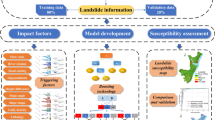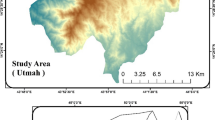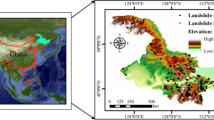Abstract
This study reports a quantitative pattern of landslide hazard in cold regions, triggered by multiple climatic factors. Different machine learning models were first employed to analyze the stability of the disaster-pregnant environment of landslides. Subsequently, the temperature difference and precipitation weakening the geotechnical body were regarded as the triggering factors of landslides in cold regions, and their marginal distribution and interdependence were determined based on the copula theory to develop the joint distribution from the perspective of exceedance probability. Landslide hazard under different return periods (T = 5, 10, 20, and 50 years) was then identified in terms of the product of the permanent environment and the triggering factor. Results show that decision tree (DT)-boosting maintains high prediction for the disaster-pregnant environment, with AUC of 0.978 and 0.859, respectively, in the training and test phases, and the high susceptibility is concentrated in the central and southeastern parts of the study area. Further, the Gumbel copula keeps the smallest distance to the empirical copula, better portraying the interdependence of triggering factors. Specifically, the probability of landslide hazard decreases as the return period increases, while the intensity increases. This study provides a window to accurately capture the landslide hazard caused by fluctuations in multiple climate factors in cold regions.











Similar content being viewed by others
References
Achour, Y., & Pourghasemi, H. R. (2020). How do machine learning techniques help in increasing accuracy of landslide susceptibility maps? Geoscience Frontiers, 11, 871–883.
Akinci, H., & Zeybek, M. (2021). Comparing classical statistic and machine learning models in landslide susceptibility mapping in Ardanuc (Artvin), Turkey. Natural Hazards, 108, 1515–1543.
Basharat, M., Riaz, M. T., Jan, M. Q., Xu, C., & Riaz, S. (2021). A review of landslides related to the 2005 Kashmir Earthquake: Implication and future challenges. Natural Hazards, 108, 1–30.
Chang, M., Cui, P., Dou, X., Su, F. (2021). Quantitative risk assessment of landslides over the China–Pakistan economic corridor. International Journal of Disaster Risk Reduction, 63
Corominas, J., van Westen, C., Frattini, P., Cascini, L., Malet, J. P., Fotopoulou, S., Catani, F., Van Den Eeckhaut, M., Mavrouli, O., Agliardi, F., Pitilakis, K., Winter, M. G., Pastor, M., Ferlisi, S., Tofani, V., Hervás, J., & Smith, J. T. (2013). Recommendations for the quantitative analysis of landslide risk. Bulletin of Engineering Geology and the Environment, 73, 209–263.
Dai, Q., Rico-Ramirez, M. A., Han, D., Islam, T., & Liguori, S. (2015). Probabilistic radar rainfall nowcasts using empirical and theoretical uncertainty models. Hydrological Processes, 29, 66–79.
Ding, Y., Zhang, S., Zhao, L., Li, Z., & Kang, S. (2019). Global warming weakening the inherent stability of glaciers and permafrost. Science Bulletin, 64, 245–253.
Dou, J., Yunus, A. P., Tien Bui, D., Merghadi, A., Sahana, M., Zhu, Z., Chen, C. W., Khosravi, K., Yang, Y., & Pham, B. T. (2019). Assessment of advanced random forest and decision tree algorithms for modeling rainfall-induced landslide susceptibility in the Izu-Oshima Volcanic Island, Japan. Science of the Total Environment, 662, 332–346.
Erener, A., & Düzgün, H. B. S. (2012). A regional scale quantitative risk assessment for landslides: Case of Kumluca watershed in Bartin, Turkey. Landslides, 10, 55–73.
Fan, Y., Huang, G., Zhang, Y., & Li, Y. (2018). Uncertainty quantification for multivariate eco-hydrological risk in the Xiangxi river within the Three Gorges Reservoir Area in China. Engineering, 4, 617–626.
Fell, R., Corominas, J., Bonnard, C., Cascini, L., Leroi, E., & Savage, W. Z. (2008). Guidelines for landslide susceptibility, hazard and risk zoning for land-use planning. Engineering Geology, 102, 99–111.
Feng, J., Li, N., Zhang, Z., & Chen, X. (2017). How to apply the dependence structure analysis to extreme temperature and precipitation for disaster risk assessment. Theoretical and Applied Climatology, 133, 297–305.
Fu, S., Chen, L., Woldai, T., Yin, K., Gui, L., Li, D., Du, J., Zhou, C., Xu, Y., & Lian, Z. (2020). Landslide hazard probability and risk assessment at the community level: A case of western Hubei, China. Natural Hazards and Earth System Sciences, 20, 581–601.
Goetz, J. N., Brenning, A., Petschko, H., & Leopold, P. (2015). Evaluating machine learning and statistical prediction techniques for landslide susceptibility modeling. Computers & Geosciences, 81, 1–11.
Huang, Y., & Zhao, L. (2018). Review on landslide susceptibility mapping using support vector machines. CATENA, 165, 520–529.
Huggel, C., Salzmann, N., Allen, S., Caplan-Auerbach, J., Fischer, L., Haeberli, W., Larsen, C., Schneider, D., & Wessels, R. (2010). Recent and future warm extreme events and high-mountain slope stability. Philosophical Transactions of the Royal Society a: Mathematical, Physical and Engineering Science, 368, 2435–2459.
Ko, F. W. Y., & Lo, F. L. C. (2018). From landslide susceptibility to landslide frequency: A territory-wide study in Hong Kong. Engineering Geology, 242, 12–22.
Krøgli, I. K., Devoli, G., Colleuille, H., Boje, S., Sund, M., & Engen, I. K. (2018). The Norwegian forecasting and warning service for rainfall- and snowmelt-induced landslides. Natural Hazards and Earth System Sciences, 18, 1427–1450.
Lazoglou, G., & Anagnostopoulou, C. (2018). Joint distribution of temperature and precipitation in the Mediterranean, using the Copula method. Theoretical and Applied Climatology, 135, 1399–1411.
Lee, S. (2019). Current and future status of GIS-based landslide susceptibility mapping: A literature review. Korean Journal of Remote Sensing, 35, 179–193.
Li, H., Xu, Q., He, Y., & Deng, J. (2018). Prediction of landslide displacement with an ensemble-based extreme learning machine and copula models. Landslides, 15, 2047–2059.
Lin, Q., Wang, Y., Glade, T., Zhang, J., & Zhang, Y. (2020). Assessing the spatiotemporal impact of climate change on event rainfall characteristics influencing landslide occurrences based on multiple GCM projections in China. Climatic Change, 162, 761–779.
Liu, Q., Huang, D., Tang, A., & Han, X. (2021). Model performance analysis for landslide susceptibility in cold regions using accuracy rate and fluctuation characteristics. Natural Hazards, 108, 1047–1067.
Liu, Q., Tang, A. (2022). Exploring aspects affecting the predicted capacity of landslide susceptibility based on machine learning technology. Geocarto International, 1–20
Liu, Q., Tang, A., Huang, Z., Sun, L., Han, X. (2022a). Discussion on the tree-based machine learning model in the study of landslide susceptibility. Natural Hazards
Liu, Q., Tang, A., Shao, E., Han, X. (2022b). Probabilistic analysis of landslide hazard: considering the dependence between hazard components. Geocarto International, 1–22
Lombardo, L., Tanyas, H., Huser, R., Guzzetti, F., & Castro-Camilo, D. (2021). Landslide size matters: A new data-driven, spatial prototype. Engineering Geology, 293, 1–28.
Ma, Z., Mei, G., & Piccialli, F. (2020). Machine learning for landslides prevention: a survey. Neural Computing and Applications, 33, 10881.
Merghadi, A., Yunus, A. P., Dou, J., Whiteley, J., ThaiPham, B., Bui, D. T., Avtar, R., & Abderrahmane, B. (2020). Machine learning methods for landslide susceptibility studies: A comparative overview of algorithm performance. Earth-Science Reviews, 207, 103225.
Motamedi, M., & Liang, R. Y. (2013). Probabilistic landslide hazard assessment using Copula modeling technique. Landslides, 11, 565–573.
Mulinacci, S. (2017). Archimedean-based Marshall-Olkin distributions and related dependence structures. Methodology and Computing in Applied Probability, 20, 205–236.
Nachappa, T. G., Ghorbanzadeh, O., Gholamnia, K., Blaschke, T. (2020). Multi-hazard exposure mapping using machine learning for the State of Salzburg, Austria. Remote Sensing, 12
Nguyen-Huy, T., Deo, R. C., Mushtaq, S., Kath, J., & Khan, S. (2019). Copula statistical models for analyzing stochastic dependencies of systemic drought risk and potential adaptation strategies. Stochastic Environmental Research and Risk Assessment, 33, 779–799.
Palaro, H. P., & Hotta, L. K. (2006). Using conditional copula to estimate value at risk. Journal of Data Science, 4, 93–115.
Patton, A. I., Rathburn, S. L., & Capps, D. M. (2019). Landslide response to climate change in permafrost regions. Geomorphology, 340, 116–128.
Peng, L., Xu, S., Hou, J., & Peng, J. (2014). Quantitative risk analysis for landslides: The case of the Three Gorges area, China. Landslides, 12, 943–960.
Pflug, G. C., & Pichler, A. (2018). Systemic risk and copula models. Central European Journal of Operations Research, 26, 465–483.
Pham, V. D., Nguyen, Q.-H., Nguyen, H.-D., Pham, V.-M., Vu, V. M., & Bui, Q.-T. (2020). Convolutional neural network—optimized moth flame algorithm for shallow landslide susceptible analysis. IEEE Access, 8, 32727–32736.
Pourghasemi, H. R., & Rahmati, O. (2018). Prediction of the landslide susceptibility: Which algorithm, which precision? CATENA, 162, 177–192.
Pourghasemi, H.R., Teimoori Yansari, Z., Panagos, P., Pradhan, B. (2018). Analysis and evaluation of landslide susceptibility: a review on articles published during 2005–2016 (periods of 2005–2012 and 2013–2016). Arabian Journal of Geosciences, 11
Reichenbach, P., Rossi, M., Malamud, B. D., Mihir, M., & Guzzetti, F. (2018). A review of statistically-based landslide susceptibility models. Earth-Science Reviews, 180, 60–91.
Sarkar, S., Pandit, K., Dahiya, N., & Chandna, P. (2021). Quantified landslide hazard assessment based on finite element slope stability analysis for Uttarkashi-Gangnani Highway in Indian Himalayas. Natural Hazards, 106, 1895–1914.
Shano, L., Raghuvanshi, T.K., Meten, M. (2020). Landslide susceptibility evaluation and hazard zonation techniques—a review. Geoenvironmental Disasters, 7
Song, S., Qian, Y., Liu, J., Xie, X., & Wu, G. (2019). Time-variant fragility analysis of the bridge system considering time-varying dependence among typical component seismic demands. Earthquake Engineering and Engineering Vibration, 18, 363–377.
Swanson, D. K. (2021). Permafrost thaw-related slope failures in Alaska’s Arctic National Parks, c. 1980–2019. Permafrost and Periglacial Processes, 32, 392–406.
Tapia Baldis, C., & TrombottoLiaudat, D. (2019). Rockslides and rock avalanches in the Central Andes of Argentina and their possible association with permafrost degradation. Permafrost and Periglacial Processes, 30, 330–347.
Tien Bui, D., Shirzadi, A., Shahabi, H., Geertsema, M., Omidvar, E., Clague, J., Thai Pham, B., Dou, J., Talebpour Asl, D., Bin Ahmad, B., & Lee, S. (2019). New ensemble models for shallow landslide susceptibility modeling in a semi-arid watershed. Forests, 10, 1–23.
Viani, C., Chiarle, M., Paranunzio, R., Merlone, A., Musacchio, C., Coppa, G., & Nigrelli, G. (2020). An integrated approach to investigate climate-driven rockfall occurrence in high alpine slopes: The Bessanese glacial basin, Western Italian Alps. Journal of Mountain Science, 17, 2591–2610.
Wang, G., Lei, X., Chen, W., Shahabi, H., & Shirzadi, A. (2020a). Hybrid computational intelligence methods for landslide susceptibility mapping. Symmetry, 12, 1–20.
Wang, Y., Feng, L., Li, S., Ren, F., & Du, Q. (2020b). A hybrid model considering spatial heterogeneity for landslide susceptibility mapping in Zhejiang Province, China. CATENA, 188, 104425.
Weidner, L., DePrekel, K., Oommen, T., & Vitton, S. (2019). Investigating large landslides along a river valley using combined physical, statistical, and hydrologic modeling. Engineering Geology, 259, 105169.
Wu, C. Y., & Chen, S. C. (2013). Integrating spatial, temporal, and size probabilities for the annual landslide hazard maps in the Shihmen watershed, Taiwan. Natural Hazards and Earth System Sciences, 13, 2353–2367.
Wu, X., Chen, X., Zhan, F. B., & Hong, S. (2015). Global research trends in landslides during 1991–2014: A bibliometric analysis. Landslides, 12, 1215–1226.
Yi, Y., Zhang, Z., Zhang, W., Jia, H., & Zhang, J. (2020). Landslide susceptibility mapping using multiscale sampling strategy and convolutional neural network: A case study in Jiuzhaigou region. CATENA, 195, 104851.
Yu, G.-A., Yao, W., Huang, H. Q., & Liu, Z. (2020). Debris flows originating in the mountain cryosphere under a changing climate: A review. Progress in Physical Geography: Earth and Environment, 45, 339–374.
Zhang, Y.-X., Lan, H.-X., Li, L.-P., Wu, Y.-M., Chen, J.-H., & Tian, N.-M. (2020). Optimizing the frequency ratio method for landslide susceptibility assessment: A case study of the Caiyuan Basin in the southeast mountainous area of China. Journal of Mountain Science, 17, 340–357.
Zhang, Y., Kim, C.-W., Beer, M., Dai, H., & Soares, C. G. (2018). Modeling multivariate ocean data using asymmetric copulas. Coastal Engineering, 135, 91–111.
Zhao, B., Dai, Q., Han, D., Dai, H., Mao, J., & Zhuo, L. (2019). Probabilistic thresholds for landslides warning by integrating soil moisture conditions with rainfall thresholds. Journal of Hydrology, 574, 276–287.
Zhao, D.-M., Jiao, Y.-M., Wang, J.-L., Ding, Y.-P., Liu, Z.-L., Liu, C.-J., Qiu, Y.-M., Zhang, J., Xu, Q.-E., & Wu, C.-R. (2020). Comparative performance assessment of landslide susceptibility models with presence-only, presence-absence, and pseudo-absence data. Journal of Mountain Science, 17, 2961–2981.
Zhao, X., & Chen, W. (2020). Optimization of computational intelligence models for landslide susceptibility evaluation. Remote Sensing, 12, 2180.
Zhu, A. X., Miao, Y., Liu, J., Bai, S., Zeng, C., Ma, T., & Hong, H. (2019). A similarity-based approach to sampling absence data for landslide susceptibility mapping using data-driven methods. CATENA, 183, 1–17.
Acknowledgements
This research is supported and funded by the National Key Research and Development Program of China (2018YFC0809605). The authors are grateful for this support, and would like to thank the professors for providing the dates used in this study as well.
Funding
Funding was provided by the National Key Research and Development Program of China (Grant no. 2018YFC0809605).
Author information
Authors and Affiliations
Corresponding author
Ethics declarations
Conflict of interest
The authors declare that there is no conflict of interest. Some or all data, models, or codes generated or used during the study are available from the corresponding author by request.
Additional information
Publisher's Note
Springer Nature remains neutral with regard to jurisdictional claims in published maps and institutional affiliations.
Rights and permissions
Springer Nature or its licensor holds exclusive rights to this article under a publishing agreement with the author(s) or other rightsholder(s); author self-archiving of the accepted manuscript version of this article is solely governed by the terms of such publishing agreement and applicable law.
About this article
Cite this article
Liu, Q., Tang, A., Tao, X. et al. Probabilistic Analysis of the Landslide Hazard in Cold Regions: Considering Multiple Triggering Factors and Their Interdependence. Pure Appl. Geophys. 179, 4063–4077 (2022). https://doi.org/10.1007/s00024-022-03152-3
Received:
Revised:
Accepted:
Published:
Issue Date:
DOI: https://doi.org/10.1007/s00024-022-03152-3




